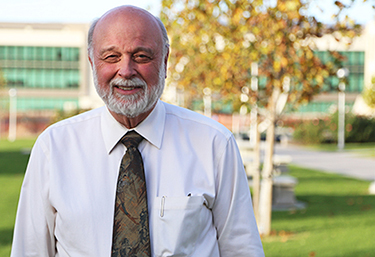 |
| November 2015 |
|
Justice
Institutions and organizations of all kinds talk a lot about values these days. It seems we hope that talking will instill these virtues into our people and cultures. We recognize that values are so central to our beings that they are probably not something we can “teach” in any traditional Some 15-20 years ago, Lyn Behrens, our president at the time, assembled a group of us from Loma Linda University to discuss and state our “core values.” It was tough work — months of word-smithing, struggling to identify the basic concepts and determine how words overlap, etc. But finally we came up with seven values that are now being used at Loma Linda University. To help remember them, Billy Hughes, our soon-to-retire dean of the School of Pharmacy, came up with a good acronym — JCHIEFS — Justice, Compassion, Humility, Integrity, Excellence, Freedom and Self-Control. A few years later, in creating its own set of core values, LLU Medical Center also chose Compassion, Integrity and Excellence (what we call ICE) and added two more — Wholeness and Teamwork. In light of our corporate unification initiative, we probably should agree on a common set of values for all of us at Loma Linda University Health, but that is a battle waiting for another day. For now, I would like to periodically discuss the university’s seven values, one by one. I am not a historian, theologian or philosopher, so my approach will be rather more mundane, coming from my particular view of the world and the institution in which I live. I do find myself referring to these core values frequently as we struggle with institutional decisions built on the fundamental reasons why we exist. So here goes. Justice — it is clear that the concept of justice varies by culture, religion and people groups. The ancients struggled with this concept in many different ways, and various applications of justice have been developed — distributive justice, restorative (reparative) justice, natural justice and so on. Many trace the roots of justice to the religious world, and certainly the Old Testament is full of references to justice as a Lady Justice, an international symbol of this value, has three tools embedded in her arsenal. First is a sword, indicating the necessary enforcement aspects of justice. Next is a scale, indicating the need to balance many issues when determining what is just. And finally is a blindfold, showing the necessity of being fair to all without influence of position or power. A common feeling in society today is that some “get away with it” because of who they are or the money they have. These three aspects represent the challenges in determining and administering justice. So Justice has earned its place as a “Core Value” at Loma Linda University. One cannot adjudicate many decisions without coming up against this basic issue — what is fair, what is just? A common complaint from my grandkids — “That isn’t fair” — suggests a fundamental sense of right and wrong from early ages. But how do we view the disabled vet on the off ramp offering to work for food, or the struggling family trying to make it on a minimum wage? Loma Linda has now committed itself to a path of paying a “living wage” to its employees, a social concept catching on in this country. On the other side, we also talk about the 1 percent, those ultra-rich who impact this country through their companies and resources. Perhaps with some exceptions, I’ve got to believe these are decent people with their own internal sense of right and wrong, of justice and fairness, of personal obligations about their wealth and capacity. We all need to make our own decisions about our commitments and sharing of our personal resources. During my early professional career, I worked in Tanzania under the governmental leadership of Julius Nyerere, founding president of the country. His strong sense of justice led to a socialistic form of centralized economic planning that nearly bankrupted the country. He also launched the infamous ujamaa villages where the rural people were forced to move into planned villages to provide them with better access to social services. But his Especially now as I travel globally, I have to wonder about the fairness of life and the distribution of resources. There are mission hospitals barely surviving, students struggling to earn their way through school, children and mothers living and dying with inadequate shelter, food and health care — even as we have excesses in many areas of our lives. Our San Bernardino campus is one small step Loma Linda University Health has made to balance this equation. To learn more about the need in San Bernardino, view this documentary by the Los Angeles Times at http://graphics.latimes.com/san-bernardino-video. Even now as I drive by the new building under construction, I can envision young lives being motivated and empowered to take their rightful place in the community. Additionally, hosting Adventist Health International at Loma Linda, with its commitment to strengthen mission hospitals, is another attempt at distributive justice. My prayer is that our students, faculty, staff and alumni will share this commitment to justice for all. Respectfully,
Richard Hart, MD, DrPH |
   |
|
Office of the President, Loma Linda University, Loma Linda, CA 92350 Copyright © 2015 by Loma Linda University |
November 12, 2015
Notes from the President -- Justice
Share

 sense, but must arise from somewhere inside, from long ago, coming from our childhood or even genetics. But I believe we can “call them out” by modeling them in a way that reawakens them, reinforces them and makes them a more visible part of our everyday activities.
sense, but must arise from somewhere inside, from long ago, coming from our childhood or even genetics. But I believe we can “call them out” by modeling them in a way that reawakens them, reinforces them and makes them a more visible part of our everyday activities. compelling characteristic of God’s people. Plato wondered, “Is what is commanded by God morally good because it is morally good, or is it morally good because it is commanded by God?” In our current presidential race in America, we have a self-proclaimed “democratic socialist” who argues persuasively that this country’s resources should be more equitably distributed and utilized — justice at the economic level. These concepts stand in fairly sharp contrast to the prevailing tenor of this country’s capitalism — you get what you earn and deserve.
compelling characteristic of God’s people. Plato wondered, “Is what is commanded by God morally good because it is morally good, or is it morally good because it is commanded by God?” In our current presidential race in America, we have a self-proclaimed “democratic socialist” who argues persuasively that this country’s resources should be more equitably distributed and utilized — justice at the economic level. These concepts stand in fairly sharp contrast to the prevailing tenor of this country’s capitalism — you get what you earn and deserve. policies were a real benefit for those of us planning health care and education for the general population. Imagine having a government truly committed to providing a clinic within 10 kilometers of every citizen and primary schools within reach of all. If you had the fortune of receiving advanced education, a benefit accorded to only a few by society, it did not give you special privileges or wages beyond the norm, but only increased the “debt” of service you had to give back. As I watch young professionals in all cultures determine how to use their God-given talents, I wish we could share Nyerere’s sense of justice more widely.
policies were a real benefit for those of us planning health care and education for the general population. Imagine having a government truly committed to providing a clinic within 10 kilometers of every citizen and primary schools within reach of all. If you had the fortune of receiving advanced education, a benefit accorded to only a few by society, it did not give you special privileges or wages beyond the norm, but only increased the “debt” of service you had to give back. As I watch young professionals in all cultures determine how to use their God-given talents, I wish we could share Nyerere’s sense of justice more widely.